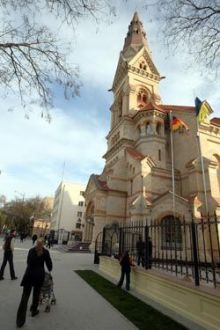ODESA — After 70 years of oblivion, the restored Lutheran Evangelical Church of St. Paul has opened in Odesa. It is one of the city’s major historic sites and the main temple of the German Evangelical Lutheran Church in Ukraine, which counts 35 parishes. The church was built with German settlers’ money in 1828 and designed by Franz Boffo. It was reconstructed in 1893. In the 1930s the cross was lifted off the church and the premises were used as a library. After WWII, the church was used as a gym and later as a warehouse. In the 1970s, pressured by international opinion, the Soviet authorities allowed restoration works, but on the night of May 9, 1976, the church was destroyed in a fire said to have been organized by the secret police. In 1992, under en edict of President Leonid Kravchuk of Ukraine, the church ruins and the adjacent elders’ home were handed over to the German Evangelical Lutheran Church of Ukraine. After repeated attempts to restore the church actual reconstruction started in October 2005.
Dr. Klaus-Jurgen Rebke, the senior religious councilor of the German Evangelical Lutheran Church of Ukraine, feels sure that this temple, which is equipped with a Steinmeier organ, will become one of Odesa’s leading music centers. Addressing the opening ceremony, Hans-Jurgen Heimsoeth, Ambassador Extraordinary and Plenipotentiary of Germany to Ukraine, read a salutatory message from the German President Horst Koehler. For many Germans Odesa has a special meaning, the message read, as at one time this city hosted a large ethnic German community that had built this church. “I am delighted to learn that this cathedral has been restored,” wrote President Koehler.
The total cost of reconstruction and equipment of the church and St. Paul’s German Center was around seven million euros. Two-thirds of the sum was donated by the Lutheran Church in Bavaria. Money was also sent by the Bavarian leadership, the Odesa community, and numerous sponsors in Germany. The project was coordinated by the German-Ukrainian firm O.L.T. Konsalt. “The main difficulties in implementing this project revolved around the status of this church as a national architectural and cultural monument. We had to collaborate closely with the agencies responsible for the protection of such monuments. We also brought the construction team to Germany for a refresher course. We wanted to restore this historic structure’s original visage and secure construction quality,” says O.L.T. Konsalt’s CEO Torsten Oswald.
The decorations for the church — old statues of Jesus Christ, Saints Peter and Paul already mounted over the altar — were donated by the Roman Catholic Church of Regensburg. Icons were contributed by private individuals from Odesa and elsewhere.
Sponsors paid for the bells that were made at Rudolf Perner’s workshop in Passau (this firm has specialized in this business for 400 years) and installed towards the end of February.
The walls and the ceiling were painted by Tobias Kammerer, a young artist from Bavaria. He has decorated several churches in Germany and Ukraine. The ceiling portrays a sea and a sailboat shaped like a church – taking into account that St. Paul was an active mariner. It is also a direct connection with the seaport of Odesa.







